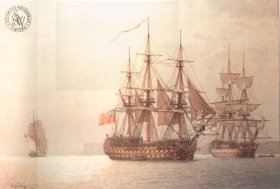HMS Glory (1788)
Appearance
 HMS Glory (center) in company with HMS Valiant
| |
| History | |
|---|---|
| Name | HMS Glory |
| Ordered | 16 July 1774 |
| Builder | Plymouth Dockyard |
| Laid down | 7 April 1775 |
| Launched | 5 July 1788 |
| Honours and awards |
|
| Fate | Broken up, 1825 |
| General characteristics [1] | |
| Class and type | Duke-class ship of the line |
| Tons burthen | 1931 bm |
| Length | 177 ft 6 in (54.10 m) (gundeck) |
| Beam | 50 ft (15 m) |
| Depth of hold | 21 ft 2 in (6.45 m) |
| Propulsion | Sails |
| Sail plan | Full-rigged ship |
| Armament |
|
HMS Glory was a 98-gun second-rate ship of the line of the Royal Navy, launched on 5 July 1788 at Plymouth.[1]
Glory served as the flagship of Rear-Admiral Sir Charles Stirling at the Battle of Cape Finisterre in 1805, commanded by Captain Samuel Warren.
She was converted to a prison ship in 1809, and was broken up in 1825.[1]
Citations and notes
References
- Lavery, Brian (2003) The Ship of the Line - Volume 1: The development of the battlefleet 1650-1850. Conway Maritime Press. ISBN 0-85177-252-8.
External links
 Media related to HMS Glory (ship, 1788) at Wikimedia Commons
Media related to HMS Glory (ship, 1788) at Wikimedia Commons
